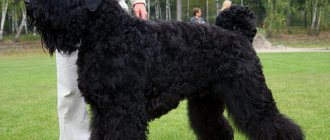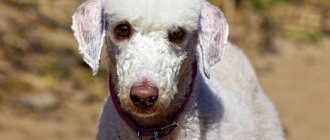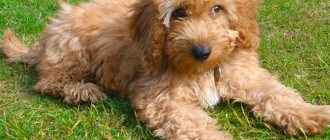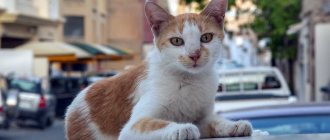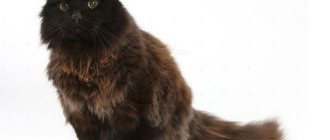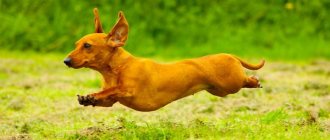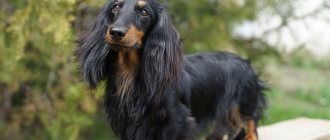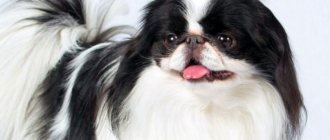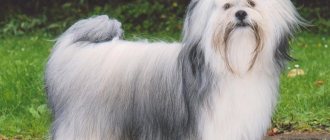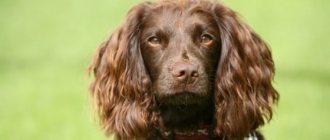The red color of dachshunds is one of the most popular. It is almost as widespread as the black and tan, which is considered the most classic of the breed.
And this is not surprising, because a bright red dachshund always looks impressive and positive.
A pet of this color will not let its owners get bored; next to it it will always be warm and sunny, like on a clear summer day.
However, like all other dogs, red dachshunds have their own breed characteristics.
Origin story
The history of red dachshunds is lost in ancient times. After all, back in Ancient Egypt, dachshund dogs with an elongated body and short legs were bred and used for hunting.
Germany is considered the homeland of dachshunds, where these dogs have long been used for hunting small burrowing game. At the same time, the first reliable information about them dates back to approximately the beginning of the 18th century, although, according to some sources, dachshunds were encountered already in the 15th century.
Considering that at that time hunters bred mainly dogs with excellent working qualities and spent less time on the exterior, it can be assumed that the ancient German dachshunds were distinguished by a large variety of colors. And, undoubtedly, among them there were many red animals.
NOTE!
The first dachshunds, bred in Germany, were longer-legged and less stocky, but their heads and muzzles already had the shape characteristic of modern dogs.
Elongated ears and a long, but strong tail are the result of selection associated with their hunting use.
Hanging ears covering the ear canal prevented soil, plant seeds and other foreign objects from entering it while digging a hole. A long, but not too thin tail was necessary so that the hunter could see the dog from a distance in the tall grass, and if the dachshund got stuck in a hole, he could grab onto it and help it get out.
Marriage or breed?
The red color is considered the standard and one of the classic coat color options for dogs of this breed.
Expert opinion
Kozhevin Semyon Kirillovich
Expert dog handler.
Red color of varying brightness and intensity is very common in dachshunds. Along with black and tan and brown and tan, this is one of the most classic colors. Depending on whether the dog has black hairs or not, it can look either bright golden-red or almost brown. But at the same time, the red shade of the coat should never be lightened to fawn or, especially, cream. The presence of unevenly colored hairs turns this color into sable or boar.
Description of the Dachshund breed
The Dachshund is one of the most popular breeds in the world. The dog's body is slightly elongated and sits on short legs. This form of the dog allows it to climb into deep and long pits of badgers. If you are far from hunting, then you can love the dachshund for its playfulness, intelligence and intelligence. Dachshunds, and especially when it comes to albinos, are not capricious and unpretentious, they love dialogue. The colors of dachshunds are so varied that you can buy a pet for every taste and color. How white dachshunds developed black noses and claws. Dachshunds come in long-haired and short-haired varieties. In general, short-haired dachshunds can be albino. Another term that characterizes white dachshunds is leucistic. They have a completely white coat, but a well-painted black nose, claws and normal eye pigmentation. Such breed characteristics are also considered normal for some breeds, white bull terriers or, for example, huskies.
Advantages and disadvantages
Pros:
- Smart and intellectual.
- Sociable and friendly pets.
- They love to play.
- Dachshunds have very funny and incredibly rich facial expressions.
- They can become good friends for children.
- They are energetic and, despite their small size, physically resilient.
- With proper maintenance and care they can live a long time.
- The dachshund is an excellent hunter of small burrowing animals.
- Dachshunds make good guards for a house or apartment.
Minuses:
- Diseases of the musculoskeletal system and spine may develop.
- Prone to obesity and overeating.
- Quite cocky towards other people's dogs.
- They can be stubborn and disobedient at times.
- They will not miss the opportunity to rummage in the ground.
Dimensions, weight and other features
There are three size varieties of dogs of this breed:
- Standard . The chest girth is from 35 cm. Such individuals weigh approximately 9 kg.
- Miniature . Chest volume - from 30 to 35 cm, weight - 4-5.5 kg.
- Rabbit . Chest circumference up to 30 cm, weight - from 3.4 to 4 kg.
The red dachshund is a short, but at the same time quite strong and strong dog with well-developed muscles. She doesn't look funny or disproportionate.
A characteristic feature of dachshunds is a highly elongated body and short, but at the same time quite strong legs. Elongated, high-set ears hanging along the cheekbones and a long, but not too thin tail are also characteristic breed characteristics of these dogs.
The head is wedge-shaped, without a pronounced transition from the forehead to the muzzle. The mouth is strong and deep, the teeth are strong and snow-white, always in full set and in a correct scissor bite.
The eyes of red dachshunds are not too large, but expressive. Set slightly askew, they can be any of the dark brown shades.
A black nose is preferred, but brown pigmentation of the earlobe is also acceptable.
Color - any shade of red or reddish-fawn. There may be an admixture of black hair, but no blackening of the hairs.
IMPORTANT!
A small white spot on the chest is not considered a fault. But if the dog has white ears, this is no longer considered a standard.
Advantages of the dachshund for burrow hunting
Dachshund constitution suitable for hunting
The Dachshund breed standard requires a “strong type” of constitution 31, in contrast to the standards of other burrowing breeds - terriers, which are characterized by a “dry type” of constitution. The characteristic body structure makes the dachshund ideal for burrow hunting.
The dachshund is the smallest burrowing hunting dog, and you have to take the animal with tactics, not force. Short legs allow the dachshund to work at its full height underground, which saves it a lot of effort. Her body is so flexible that the dachshund can turn around in narrow tunnels and “change positions.” If the animal is too strong and it is not possible to penetrate its defenses head-on, the dachshund begins to maneuver in a narrow passage, forces the animal to spin, and exhausts it in defense. And at the same time it moves towards the exit, luring out the predator.
If the animal is in a dead end and the passage is too narrow to make an exchange, the dachshund may briefly jump out of the hole, allowing the predator to get out of the dead end. This is her tactical trick, after a couple of seconds the dachshund resumes work.
Dachshund personality suitable for hunting
The nervous system of the dachshund is balanced; this dog is sanguine. The dog is active, easy to train and train for hunting. Dachshunds are characterized by extreme toughness - perseverance, endurance and reliability are characteristic of this breed. Dachshunds that are suitable for hunting are mated at work, which means they persistently pursue the animal, hang on its tail and continuously vocalize as they pursue. At the same time, they are smart and careful enough to remain unharmed and avoid injury and bites.
Very brave and courageous. The dachshund does not give in to an aggressively defending animal. In battle, he maintains composure and the ability to assess the situation and his actions. Balances his strength soberly and avoids fighting with a stronger opponent. Avoids direct confrontation if it can be avoided. Dachshunds are the least likely animals to die while hunting.
It is very important through training and training to develop the dachshund’s ability to make independent decisions; not only the result of the hunt, but also the life of the dog depends on this skill.
Dachshund performance while hunting
The dachshund is hardy and efficient, passionate about hunting. Even old dogs and sickly lactating dachshunds during the period of false whelping are interested in hunting. The dachshund's ability to hunt does not require advertising. She makes contact with the beast, forces it out of the cauldron, makes grabs, makes an exchange with an animal that is superior in size and drives it out before being shot. However, among the dachshunds there are also plenty of dogs that grab the pot. But what to do if the animal is crushed in the cauldron, since digging holes is prohibited in our country?
Pain Tolerance
Usually the dachshund is very sensitive to pain, but in the heat of battle it may not react to pain at all. Only by the short offended notes in the barking can one understand that the fox has bitten the dog; the pain only increases the aggressiveness of the hunting dachshund. In the heat of battle, a dachshund may even fall on its back to grab a taller opponent by the throat or chest.
Photos of varieties by coat type
In addition to size, red dachshunds are divided into three types, differing in the quality and texture of their coat:
- Smooth-haired . The coat is quite soft, short, lying close to the body.
- Long-haired . The coat varies in length: on the head and muzzle it is the same as that of smooth dachshunds: very short and close-fitting. On the ears, paws and body the hair is longer, quite soft and silky. At the same time, the hair of a long-haired dachshund should be thick enough so that the dog’s skin does not show through it.
- Wirehaired . Thick and coarse hair, similar to that of terriers, forming hair on the face in the form of mustaches, beards and eyebrows.
A dachshund of any of the above types can be either a standard or a reduced variety.
Life expectancy and health
The average life expectancy of dachshunds is 12-13 years. But with good heredity and quality care, representatives of this breed can live up to 15 or even 17 years.
Most dachshunds are in good health and rarely get sick, but some of the representatives of this breed may be prone to diseases such as:
- Chest deformity.
- Slipped disc syndrome.
- Eye pathologies.
- Retinal atrophy.
- Epilepsy.
- Obesity.
CAREFULLY!
It should be remembered that dachshunds are especially susceptible to spinal injuries, so you need to carefully monitor your pet so that it does not fall or jump from a height.
Education and training
The dachshund has a stubborn character, so it needs to be trained from childhood. You need to start the process with general socialization, which includes getting to know family members and other pets. During walks, she gets acquainted with her surroundings and new smells. The dog should not bark at other animals or people.
Pet training
You need to control the dog’s actions and teach him discipline through training. The process involves learning various commands. Basic exercises that are easy to teach at home include:
- "Aport." The animal brings the item on command. It's best to use your dog's favorite toys first.
- "To me". The pet approaches the owner's feet.
- "Near". The dog will remain near the owner until he allows him to leave.
The Dachshund is a stubborn dog, so it can be difficult to train. Incentives for following commands will help make the process easier. Rough treatment will only make the situation worse.
Note! You should contact a trainer in cases where you cannot teach commands on your own.
Basic care rules
Long-haired and smooth-haired red dachshunds require regular brushing. During the shedding period, you can use a furminator or a special brush to remove dead hair from shedding dogs.
Dachshunds with long hair may also need a little cosmetic trimming, such as removing hair between their toes and trimming ear hairs. The purpose of this manipulation is not only to give a more well-groomed appearance, but also to take care of the comfort of the pet itself.
Wire-haired dogs need trimming from time to time. If you wish, you can learn this art, but if the dog is a show dog, then it is better to do it with a professional groomer or in a pet salon.
Dachshunds are bathed infrequently, but only when their fur becomes dirty. And also, if necessary, clean eyes, ears and teeth.
Red dachshunds' nails are trimmed when they begin to grow too long and bend downward. In this case, only the part of the claw that has turned down is removed with a nail cutter.
Care and maintenance
Dachshunds are kept only indoors; this is due not only to short hair (in certain subspecies) and small size . Pets need to be near people at all times. Apartment conditions are perfect for dogs. They are easy to care for and no special procedures are required.
Before buying a puppy, you need to determine a place for it in the apartment, install a comfortable orthopedic bed (preferably near the owner’s bed, without direct sunlight and drafts). It is also worth purchasing bowls on low stands, toys, and hygiene products.
The breed is suitable for hunters or active families without small children . Pets need frequent walks and hunts, so it is better for homebodies or busy people to choose another dog.
Nutrition
Typically, this breed is not picky. But there are dogs that do not eat dry food or processed meat. In this case, the diet is compiled taking into account the personal characteristics of the individual. The menu should always contain proteins and carbohydrates, but what products the pet will take it from is up to the owner to decide.
Increasingly, breeders are inclined to choose dry food . It is considered comprehensive, contains all the necessary vitamins and minerals, and is easy to use and store. You can select a product based on personal data: weight, size, health status. There are specialized lines for elderly, pregnant, inactive dogs and pets with allergies.
The downside is poor digestibility due to poor quality feed. When choosing a product, you need to read reviews about it, consult with the manufacturer, and check the composition. Wheat and grains, legumes and emulsifiers are undesirable ingredients. Dachshunds are suitable for super-premium food for medium-sized breeds with increased activity.
When feeding a puppy at a kennel with a certain brand of food, the breeder will recommend it. If the owner is not satisfied with such food, then the transition should be made smoothly. At first, the dog is fed food, then one meal is replaced, and then the entire menu is changed.
Natural food has always been considered healthier, because the owner himself knows what ends up in the pet’s bowl. But, on the other hand, fresh meat is expensive, and not everyone has time to cook.
- If this feeding option is chosen, then 50% of the diet should be proteins : lean meat or offal, eggs (2 times a week), boneless sea fish (1 time a week), fermented milk products (2-3 times a week).
- Another 30-40% are cereals : porridge boiled in water or broth.
- The rest of the space can be given to vegetables and fruits .
Dogs are strictly prohibited from eating pork, butter, legumes, potatoes, flour and confectionery products. It is not recommended to feed your pet from a human table, or give fatty and fried food.
It is not recommended to mix dry and natural feeding. After each meal, the pet’s bowls are washed, but without chemicals.
- An adult Dachshund needs 500 grams of dry or natural food per day . In summer, the serving size is reduced. The amount of food also depends on the activity and weight of the pet; you should not overfeed the animal.
- Two meals a day is considered normal.
- Puppies are fed frequently. Up to 3-4 months - 5-6 times, up to six months - 3-4 times, and by one year they switch to 2 doses: morning and evening.
The bowl of water should always be full. Maintaining a drinking regime is especially important in the summer; for this purpose, people even take it for a walk. If the puppy does not drink on his own, he is given water from a pipette or syringe.
Health
Dachshunds don't get sick often. Even with a non-standard physique, this breed is less prone to problems with joints and ligaments than others. On average, animals can live up to 17 years, although much depends on their care.
To avoid unwanted problems, you need to consult with the breeder, look at the pet’s pedigree and analyze the diseases (if any) of its parents.
Vaccinations
Hunting dogs are the most in need of vaccination because they deal with wild animals. Most often, they are the carriers of the virus. Vaccination should be annual, repetition of each procedure is mandatory, because the vaccine does not last long.
The first year of a puppy’s life is especially busy with procedures. As a rule, the first two are carried out in the nursery, about which the future owner is notified. A veterinary passport is also issued there, into which drug labels are pasted.
There are two main vaccinations for dogs:
- For rabies (done at 7 months and annually);
- Complex, containing components against mumps, enteritis, leptospirosis, salmonella, plague, etc. (done at 2, 2.5, 6, 12 months and repeated annually).
Vaccinations are carried out not only to protect the pet. The drug does not provide a 100% guarantee that the animal will not become infected. But vaccinated dogs tolerate diseases and treatment more easily. In addition, an unvaccinated dog cannot be transported across the border.
Before vaccination (two weeks), the puppy is dewormed using medication . The pet’s temperature is also taken on the day of the procedure. The dog must be absolutely healthy. Pregnant bitches and emaciated animals are not allowed to be vaccinated . Before the second vaccination, the puppy cannot be walked, and after each vaccination you must undergo a 14-day quarantine.
The procedure is carried out only in a veterinary clinic by experienced specialists. If an allergic reaction occurs, the dog is injected with a counteracting substance. If side symptoms persist for more than a day, you should consult a doctor.
Diseases
Common breed diseases:
- Cataract;
- Inflammation of the genitourinary passages;
- Obesity;
- Allergies;
- Problems with intervertebral discs, hernias;
- Heart problems.
Walk
- Pets need long walks: twice a day for 1.5 hours. Moreover, the dog needs to run, play, and train. The best thing, of course, is hunting or its imitation. If this is not possible, then simple physical exercises on dog parks, running for rings and a ball will do.
- Puppies cannot be loaded . From 2-3 months, the animal is accustomed to the street: first, it is carried in your arms for 20 minutes , then put on a leash and walked for 30 minutes 3-4 times a day . Later they are transferred to walking twice a day. The leash can be removed only when the puppy learns the commands and obeys the owner.
- The pet must know that it is always fun to be with the owner; for this, the owner must have all the dog’s attention. There are special games and trainings. For example, “Find Me,” when a person is hiding behind a tree, and the puppy needs to find him.
During the warm season, Dachshunds can swim in bodies of water, although direct sunlight should be avoided. In winter, it is recommended to wear protective overalls on your pets.
Grooming
Caring for your Dachshund depends on its type. A smooth-haired dachshund is wiped with suede or any soft cloth a couple of times a week, getting rid of dead hairs.
- Wire-haired dachshunds are trimmed approximately once every 3-4 months , using special pliers for this purpose. Long-haired pets should be brushed every day using a brush with long metal teeth.
- Bathing should be done once every 10 days . After walks, it is enough to wipe the animal’s fur and paws.
- Brush your teeth 3 to 4 times a week using paste or chewing cords. Also, you should examine your eyes and ears daily for the presence of discharge or inflammation, and wipe them as they become dirty.
- In summer, treat for fleas and ticks.
- Deworming is needed every 2 months.
- When cold weather sets in, your pet should be dressed in special protective overalls.
How to choose a puppy?
Nowadays, it is not difficult to purchase a red dachshund. Minor difficulties may arise only when searching for a long-haired rabbit or miniature dachshund.
But in any case, you need to remember that only buying a puppy in a nursery or from a breeder recommended by the club can guarantee that the pet is a dachshund, and not a mestizo or mongrel.
It is very important to carefully consider the choice of nursery or breeder, as well as the line from which the future pet comes. Even before purchasing it, you need to try to find out as much as possible about its parents; also, if this is not the first litter from this couple, it would be nice to look at their already grown puppies.
When choosing a baby dachshund, you need to pay attention to the fact that he looks strong and well-fed.
IMPORTANT!
Some dishonest breeders deliberately underfeed standard puppies in order to pass them off as miniature or rabbit dachshunds.
These babies grow less well and are more susceptible to infections, so you need to be especially careful when buying a puppy of a smaller variety of this breed.
It is also very important to check how the puppy hears and how freely it moves, since stiffness in movements may be evidence of problems with the spine or deformation of the chest.
A good dachshund puppy is interested in people and does not show aggression or fear towards its littermates or adult kennel dogs.
Buying white dachshunds
It is quite difficult to buy a white dachshund. This color is quite rare. Therefore, if you are lucky enough to have a completely healthy dog with this color, you are very lucky. When two marbled dachshunds are mated, the puppies will be born with white fur, but more than half of them will be deaf. Dachshunds are prolific dogs. A litter can be more than 10 puppies. Thus, when mating two albinos, more than 5 puppies will be born with congenital defects and pathologies. Albino dachshunds are bred in special nurseries or by owners, making their own efforts and posting their advertisements for the sale of albino dogs on special Internet sites, such as, for example, Avito. In America, there are specialists who breed albino dogs. And they are full and healthy.
